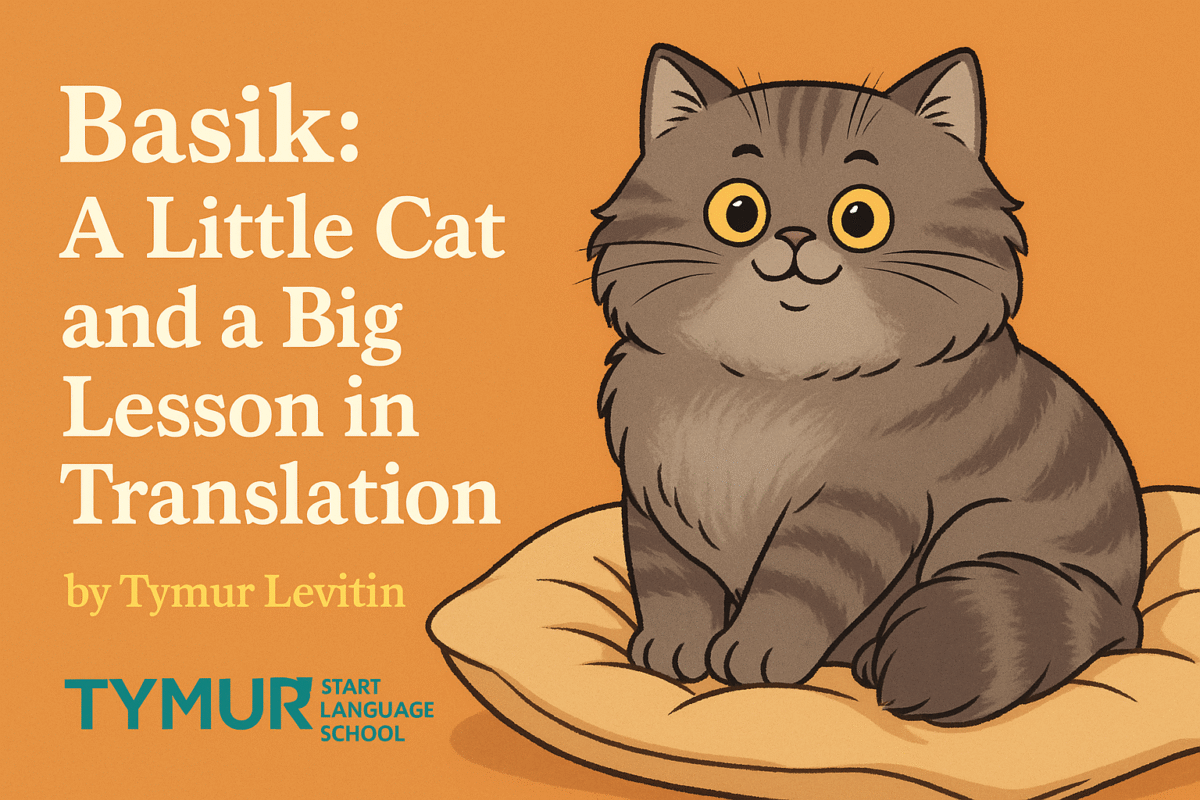Author: Tymur Levitin — founder, director, translator, and lead teacher at Levitin Language School
Official School Name: Start Language School by Tymur Levitin / Levitin Language School
Slogan: Speak free! Global Learning. Personal Approach.
📍 Choose your language
🐾 Learn German | Learn Ukrainian
Introduction: Why Translate a Poem about a Cat?
Translation is never just about words — it’s about mood, rhythm, imagery, and culture. And what better way to explore this than through a playful, poetic song about Basik the cat — a furry hero whose charm purrs across three languages.
In this article, we will:
- Compare three versions of the poem: in Russian (original), Ukrainian, and German
- Analyze key translation strategies and cultural nuances
- Provide vocabulary tips and stylistic choices
- Share video examples and visual interpretations
This is a resource for learners, teachers, and translators alike — part story, part lesson, part inspiration.
🎥 Playlist with Basik translations and videos
🎵 Basik’s multilingual song files

Chapter 1 — Russian Original: A Cozy, Mischievous Home
The Russian version introduces Basik as a playful, fluffy domestic cat — the king of winter coziness.
“По подушкам тихо крался, / Пушистей нету во дворе! / Это Басик — кот проказник, / Король в уютном декабре.”
Key features:
- Cozy domestic images (подушки — pillows, варенье — jam, компот — fruit drink)
- Rhythm built around childlike musicality
- Onomatopoeia: прыг и бдыщ! — playful sounds unique to Russian
🧩 Note for learners:
- Проказник = mischief-maker (neutral or affectionate)
- Мурлычешь = to purr — used only with cats

Chapter 2 — Ukrainian Version: Dreamy and Poetic
The Ukrainian translation reimagines Basik as a tender daydream — gentle and poetic.
“Тихо крадеться на плед — / Басик, котик-мандрівник. / Рудий пухлик, любить світ, / Ніжний, лагідний на вид.”
🎥 Watch the Ukrainian version with visuals
Translation approach:
- Uses poetic metaphors: мандрівник (traveller), пухлик (cuddly/fluffy)
- Soft imagery, focus on emotions and gentleness
- Culturally adapted verbs and nouns (калюжки — puddles)
📚 New words worth learning:
- лагідний — gentle
- покривці — blankets (regional word choice)
Chapter 3 — German Version: Noble and Energetic
The German poem gives Basik a majestic presence. Here, Basik is witty, elegant, and adventurous.
“Auf den Kissen schleicht er leis’, / Basik, König stubenweis’. / Flauschig, frech und voller Schwung, / macht den Tag bei uns ganz jung.”
🎥 See the German version with song
Stylistic highlights:
- Wordplay: König stubenweis’ — king of the household
- Alliteration: flauschig, frech und voller Schwung (fluffy, cheeky, energetic)
- Rhythmic tightness in syllables (typical of German lyrical form)
🎓 Words for learners:
- Sahnetorte — cream cake
- Deckenwald — poetic for a pile of blankets (literally: blanket forest)

Chapter 4 — How Translation Shapes Meaning
Each version adapts Basik to the mood and culture of the language:
| Theme | Russian (Homey) | Ukrainian (Dreamy) | German (Noble) |
|---|---|---|---|
| Food | компот, варенье | варення, торт | Konfitüre, Sahnetorte |
| Rain | прыг и бдыщ! | брідж-калюжки | voller Macht! |
| Character | Мягкий проказник | Пухлик-мрія | Flauschige Glück |
🧠 Why this matters:
- Russian leans on home imagery and sound effects
- Ukrainian uses dreamlike tenderness
- German highlights rhythm and elegant structure
Chapter 5 — Teaching Through Poetry
For children:
- Rhymes help with memory
- Repetition of sounds boosts pronunciation
- Characters like Basik spark emotional connection
For learners of all ages:
- Learn new vocabulary in context
- Discover culture through metaphor
- Practice intonation with music
For translators:
- Choose what to preserve: meaning, rhythm, cultural nuance?
- Adapt for local audience while keeping author’s tone
- Balance rhyme with clarity
🧩 Exercise for you: Try translating the phrase: Basik, Basik — хвіст трубою! into your own language. What would you keep? What would you adapt?

Chapter 6 — Language Paths: Where to Start
✨ Inspired? Here are resources to begin or continue your language journey:
- How to learn foreign languages with a tutor in an online language school
- Studying German is easier than you think
- The benefits of learning German with a professional tutor
- German Language Levels Guide
- German for Beginners
And if you’re quietly curious about Russian, we also have resources.

Author’s Note
This article is an original publication by Tymur Levitin — founder, director and translator at Levitin Language School (Start Language School by Tymur Levitin). All lyrics, translations, and visuals are protected by copyright.
🎨 Cover and illustrations created by AI under Tymur Levitin’s creative direction.
🔗 Official blog: https://levitinlanguageschool.com/blog/
🔗 International site: https://languagelearnings.com
📩 Telegram: @start_school_tymur | @START_SCHOOL_TYMUR_LEVITIN
✨ Speak free. Learn smart. Discover the world with Basik.
























